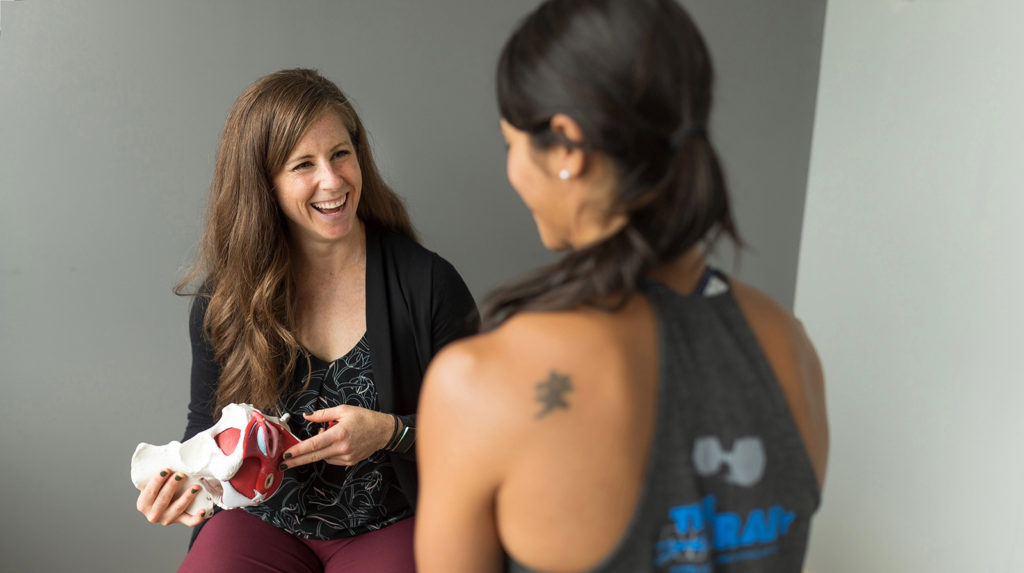
by Brittany Klingmann
Why it’s important to build awareness…
As an Orthopedic and Pelvic Health Physiotherapist I am passionate about helping those who live with symptoms related to pelvic floor dysfunction. Over the years what I consistently find is most are under the impression that these are normal consequences of: aging (peri-menopause/menopause), pregnancy/childbirth or painful intercourse (just to name a few), or due to stigma associated with it, are not worried about speaking on the topic for example: painful sex. All to often individuals are told (without any form of assessment) that they just have to do KEGELS, and when their symptoms do not improve or they develop additional or worsening symptoms, they become even more frustrated or defeated believing pelvic floor physio does not help after all.
I believe providing individuals with education around the pelvic floor and its role as part of an integrated system is an essential step in holistic care.
What is the pelvic floor???
The pelvic floor is a group of muscles that make up the bowl of the pelvis. It has many important roles in our body:
- Support: Pelvic organs (bladder, rectum and uterus) against gravity and increases intrabdominal pressure.
- Stability: Because of their attachments to the pelvis and hips, the pelvic floor muscles are an important part of our “deep canister/core”. It functions as part of a team of muscles (more detail to come).
- Sphincteric (clamp): The muscles of the pelvic floor also wrap around and control the openings of the bladder and rectum. When the pressure increases like with double unders, box jumps or heavy lifts these muscles need to be able to respond to prevent leaking. Like a clamp on a hose.
- Sexual: During intercourse the pelvic floor muscles help achieve and sustain an erection, and are necessary for orgasm, but too much tension or increased sensitivity can contribute to pain during or after intercourse.
- Sump-pump: Help move blood/lymphatic fluid back towards the heart
What other muscles make up the “deep canister/core”?
The deep anchor of the body is like a canister. Our main breathing muscle – the diaphragm makes up the top, the pelvic floor muscles make up the bottom and the transverse abdominus and multifidi make up the walls. When things are functioning as they should, this system is anticipatory and reflexive – meaning it will come on prior to us needing them, as much as they need to, without us needing to think about it! Wonderful right?!! But this can be disrupted by a number of things including, but not limited to, back/hip/pelvic pain or injury, pregnancy/childbirth, reduced joint mobility, or muscle weakness. When this occurs, we often develop altered strategies to create trunk stability – often these are less efficient and may result in trouble down the line.
What are signs that this deep anchor is not functioning as it should?
- Leaking pee or gas with high impact activities or cough/sneeze.
- Pelvic pressure/heaviness during/following activity.
- Urinary urgency or increased frequency.
- Painful intercourse.
- Coning/doming at the abdominal wall.
- Tailbone (coccyx) pain
- Constant, intermittent, or “nagging” hip/low back/pelvic pain or injuries.
- Breath holding during exercise.
It’s about more than doing KEGELS!
Often, the pelvic floor becomes the victim. The pelvic floor needs to be incorporated as part of the integrated system as it was designed. Kegels – or pelvic floor muscle contractions are only a part of the muscles function, and if told to do Kegels without an appropriate assessment this can aggravate certain types of pelvic floor conditions that are related to overactive pelvic floor muscles such as: endometriosis, interstitial cystitis, coccydynia, vaginismus.
The pelvic floor should be able to contract strongly in responses to rapid increases in intra-abdominal pressure such as with a cough/sneeze, as well as work constant at a low level when standing on our feet all day. It needs to be able to contract/and relax (move through range), just like your bicep would shorten and lengthen when you bend and straighten your elbow during the day.
There are many ways to manage your pelvic health – beyond doing Kegels!
